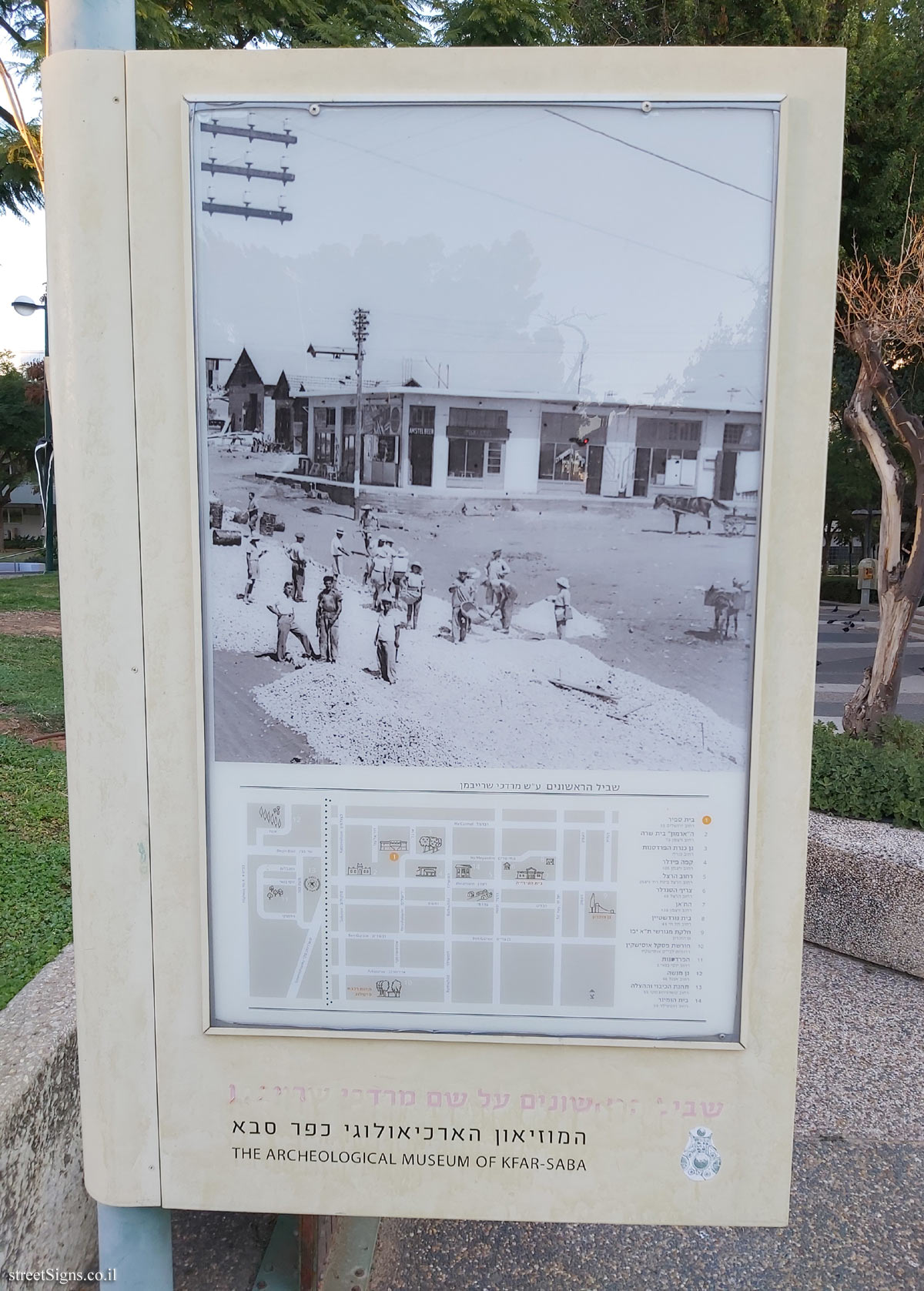On the sign:
שביל הראשונים ע"ש מרדכי שרייבמן
[תמונה: אריזת תפוזים]
[מפת השביל]
המוזיאון הארכיאולוגי כפר סבא
THE ARCHEOLOGICAL MUSEUM OF KFAR-SABA
[הצד השני של השלט]
הפרדסנות במושבה
Citrus Growing in the Settlement
במחצית השנייה של שנות העשרים של המאה ה-20, עם התרחבות ענף ההדרים שהחליפו את השקדים, הסתמן שינוי במושבה.
אדמות החול האדום (חמרה) של כפר-סבא נמצאו מתאימות לנטיעת הדרים ועד סוף העשור הקיפו פרדסים בשטח של כ-2,000 דונם את המושבה מכל עבריה. כמו במושבות אחרות במישור החוף, הפכו ההדרים בכפר-סבא לענף ראשון במעלה למשך שנים רבות.
במהלך שנות השלושים עברה המושבה, כמו היישוב היהודי כולו, תהליך התפתחות מואץ. בראש הפירמידה הכלכלית והתעסוקתית ניצב בכל אותן שנים ענף ההדרים, שהעסיק בעונת החורף - ימי הקטיף, הראיזה והמשלוח - מאות ואף אלפי עובדים. משקיעים מארצות חוץ ביקשו לרכוש כאן פרדסים ואף לטעת חדשים. במשך שנים אחדות הועסקו בענף רק עובדים יהודים, וכפר-סבא התגאתה, כמו יתר יישובי השרון, ב"עבודה עברית". אולם כשגברה בחורף 1934 הדרישה לכוח-אדם, ופועלים יהודים לא היו בנמצא, נאלצו הפרדסנים להעסיק ערבים, שהיוו כוח עבודה זול, מעשה שגרם לאחד העימותים הקשים בתולדות המושבה והיישוב היהודי כולו, שנמשך שנים אחדות.
הסתדרות העובדים עמדה על כך שעבודות הקטיף והאריזה יבוצעו רק בידי יהודים. האיכרים טענו שאין הם מקבלים די עובדים והעסיקו ערבים. הפועלים היהודים ארגנו משמרות-מחאה בהשתתפות מנהיגים, מורים וסופרים בשערי הפרדסים שהעסיקו ערבים. הדברים הגיעו לידי עימותים והמשטרה הבריטית התערבה ואסרה אחדים ממנהיגי הפועלים. המאבק נכשל אך היה לו ערך חינוכי ניכר והוא הפך למיתוס מקומי.
החל מאמצע שנות ה-30 חל מפנה של ממש בענף והביקוש לרכישת קרקעות ולנטיעות חדשות הצטמצם, עד שהעיסוק בענף הפרדסנות הפך לנטל כלכלי שלא ניתן היה להתמודד איתו.
מלחמת העולם השנייה גרמה לניתוק מהשווקים באירופה ושיתקה את הענף כליל. בשנת 1943 הוקמו במושבה שני בתי חרושת למיצי הדרים, "פריכוז" ו"מיצארון", שהיו מבשרי התעשייה במושבה. הם העסיקו כ-120 עובדים במשך עונה קצרה של כארבעה חודשים בשנה. החל תופעה, שתלך ותגבר עם השנים, של מכירת שטחי פרדסים לשימושי קרקע שאינם חקלאיים. בשנות ה-40, שנות פעילות המחתרות כנגד השלטון הבריטי, הותקנו בפרדסים "סליקים" חבויים להטמנת הנשק.
During the second half of the 1920s, with the expansion of the citrus branch that replaced the growing of almonds, a change took place in the settiement.
The red, sandy soil of Kfar Saba was found suitable for growing citrus fruit and citrus groves covering about 2000 dunam surrounded the entire settlement during that decade. As in other settlements along the coastal plain, citrus became the main crop for many years.
During the 1930s the settlement, as well as the entire Jewish settlement, underwent enormous development. At the top of the economic and employment pyramid was the citrus groing branch, that during the winter months - picking, packing and sending - empiloyed hundreds if not thousands of workers. Investors from abroad wanted to acquire citrus groves here and aso to plant new ones. For several years the branch only employed Jewish workers, and Kfar Saba prided itself as did the other settlements in the Sharon region on "Jewish labor". However, in the winter of 1934, there was, an increased demand for manpener and Jewish workers couldn’t be found. The citrus growers were forced to hire Arabs, who were a cheap source of manpower. This caused one of the most difficult conflicts in the history of the settiement and in the Jewish yishuv and it continued for a number of years.
The Histadrut Labor Federation insisted that picking and packing should be done only by Jewish hands. The farmers claimed that they didn’t have enough workers and so they hired Arabs. The Jewish workers organized demonstrations at the gates of the citrus groves where there were Arab workers, that Included leaders, teachers and authors. The situation reached the confrontation stage, the British police intervened and arrested several of the workers’ leaders. The struggle failed, but it had educational value and it became a local myth. In the middle of the 1930s there was a significant turnaround in the branch and the request to acquire land and to plant new groves decreased. Working in the citrus branch became so economically unfeasible that it could no longer be coped with.
The Second World War disconnected the growers from the European markets and totally paralyzed the branch. In 1943 two factories were built in the settlement to produce citrus juices, "Pricuz" and "Mitzaron". These factories were the beginning of industry In the settlement. They employed about 120 workers during their short working period of about four months a year. A new phenomenon started, which grew over the years, of selling off citrus groves and using the land for non-agricultural purposes.
During the 1940s, years of underground activity against the British Mandate, the cirus groves became caches for hiding weapons.
סמל העיר כפר סבא
סמל מוזיאון כפר סבא
שביל הראשונים על שם מרדכי שרייבמן
המוזיאון הארכיאולוגי כפר-סבא
ירושלים 35 כפר-סבא
טלפון 09.7640867
THE ARCHAEOLOGICAL MUSEUM OF KFAR-SABA
www.kfar-saba-museum.org

 Click for a larger image
Click for a larger image  Click for a larger image
Click for a larger image  Click for sign's details
Click for sign's details  Click for sign's details
Click for sign's details